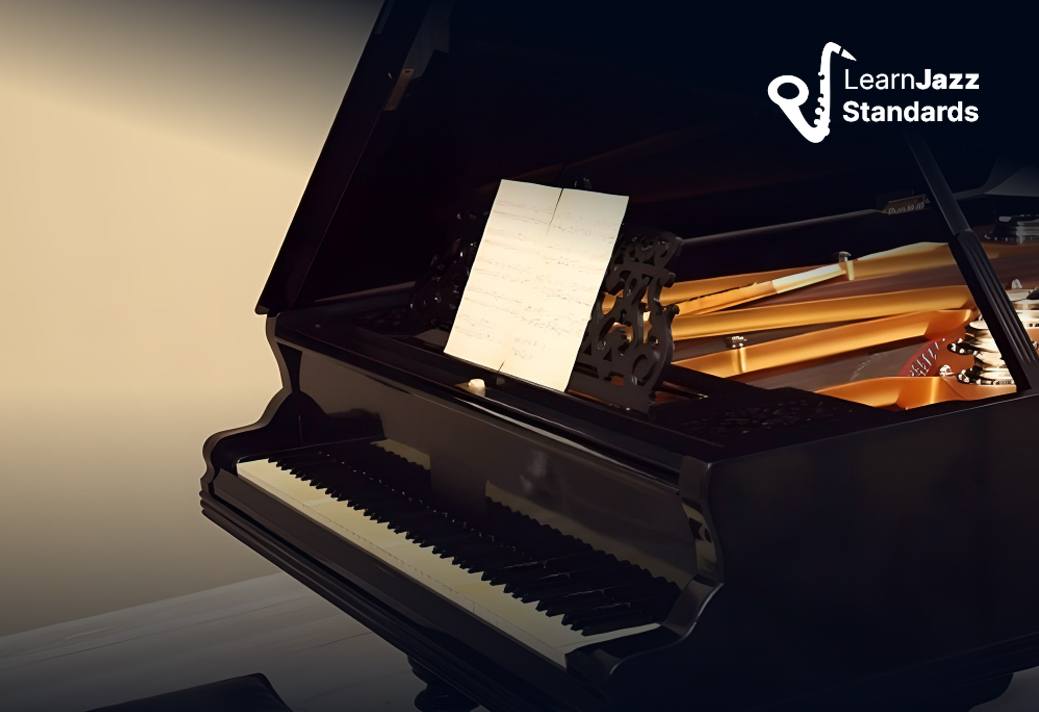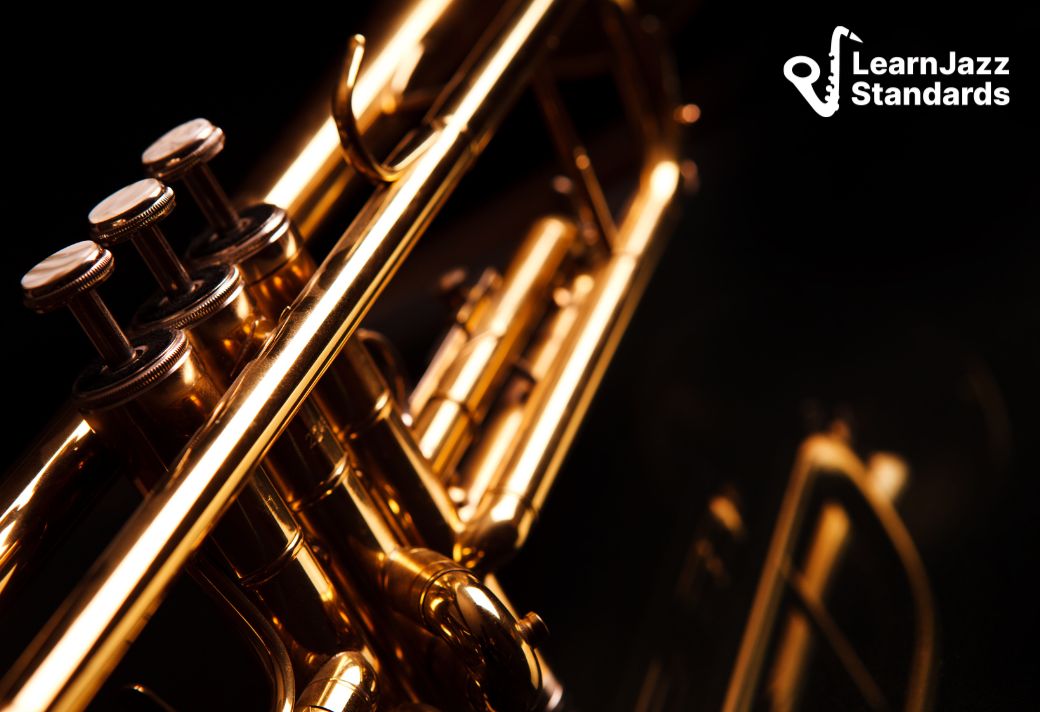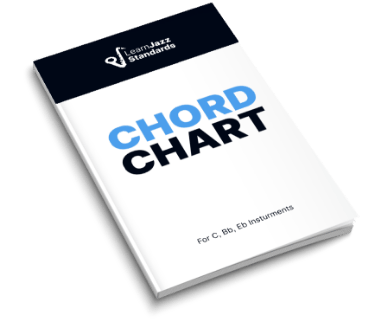One of jazz music’s most prominent characteristics is its rich harmony, and nothing quite captures jazz harmony like jazz piano chords.
Unlike many other forms of music, it’s full of intricate chord progressions and full-bodied chords. It can look a little intimidating to an outsider looking in, but anyone with a basic knowledge of chord structures is not too far off!
In this post, we will explore 15 basic jazz piano chords you should incorporate into your jazz piano playing, whether you are new to playing jazz piano or have been trying to improve your chops for a while.
The jazz piano chords we’ll cover are found across so many common jazz chord progressions. By learning these 15 jazz piano chords (in every key), you can play through any jazz standard chord progression you come across.
We’ll cover all the essential jazz piano chords—major chords, dominant chords, minor chords, diminished chords, and essential extensions so you’ll be able to sit in with other jazz musicians at the next jam session.
Some of the jazz chords we’ll cover include:
- Major 7th Chords
- Major 9th Chords
- Major 6/9 Chords
- Dominant 7th Chords
- Dominant 9 Chords
- Dominant 7(b9) Chords
- Dominant 7(#9) Chords
- Dominant 7(#5) Chords
- Dominant 7(b5) Chords
- Minor 7th Chords
- Minor 9 Chords
- Minor 6 Chords
- Minor 7(b5) Chords
- Fully Diminished 7th Chords
Before diving into jazz piano chords, here’s a quick question:
Are you feeling stuck on your jazz piano journey? Do you take lesson after lesson but can’t seem to make forward progress? Like many jazz musicians, you probably know about the importance of practicing, but did you know that practicing is a skill that requires…well, a bit of practice?
The vast majority of piano players hit a wall with practice and never progress past a certain point.
If you want to join a community of avid jazz players who are serious about learning how to practice effectively, then you need to check out our Inner Circle.
When you join, you’ll be able to access our Jazz Piano Accelerator course, which contains 16 lessons designed to take your jazz piano playing to the next level. If you are looking for a proven, systematic way to build your jazz piano chops, this is it.
Don’t miss out!
Now, let’s dive in and start discovering all of the jazz piano chords you’ll need to know to play jazz piano like Ahmad Jamal!
Table of Contents
A Quick Word On Jazz Chords and Jazz Harmony
Though jazz musicians might use a different word or chord symbol to describe a chord tone, scale degree, or other features of jazz music, jazz itself (and jazz theory) operates on the same basic set of rules that classical music, rock music, and other forms of music do.
Whether you are playing Au Claire De Lune, Rock the Casbah, or Giant Steps, it all is based on tertiary harmony.
So why does jazz music sound so rich, expressive, and unique?
Jazz music (and the jazz piano chords that power it) sounds so rich and textural because of the piano player’s style and the notes they choose to represent and accentuate the harmony of the moment.
What makes the jazz chords Bill Evans plays different from Thelonius Monk?
At its core, it’s both what they choose to play and how they choose to play it. From the expression in the melody and the particular chord voicings a player chooses to the right-hand or left-hand technique they use to play it—when you are listening to jazz, it’s all about the personality behind the music.
For more on jazz theory, check out our ultimate guide to jazz theory.
How To Understand The Music Theory Behind These Piano Jazz Chords
We will play all these jazz piano chords from the root note of C, so you won’t have to worry about transposing these shapes… yet!
However, to master piano jazz chords (and jazz piano more broadly), you’ll want to take these 15 jazz piano chords through all 12 keys and learn how to play their different chord inversions.
Also, we’ll give numeric formulas for each chord based on the distance away from the root note, which is C in this case. These numeric formulas are based on the twelve tones in the octave. We can build the C major scale using this formula, and it looks like this:
- C – D – E – F – G – A – B – C
- rt. – 2nd – 3rd – 4th – 5th – 6th – 7th – 8th
Therefore, a C major triad would look like this: (rt. – 3rd – 5th)
And a C major 7th chord would look like this: (rt. – 3rd – 5th – 7th)
We use (#) or (b) to denote pitches outside of C major for alterations to the numeric formula.
So, dominant jazz piano chords are spelled like this: (rt. – 3rd – 5th – b7th), and minor 7th chords are spelled like this: (rt. – b3rd – 5th – b7th).
More complex jazz piano chords with extensions and alterations follow this logic too. A G7b9/#9 chord would be spelled: (rt. – 3rd – 5th – b7th – b9 – #9).
These are not suggested voicings but visual aids to help you see them placed in order.
Check out this article on chord extensions for a deeper dive into jazz theory. For a deeper dive into 7th chords, check out our ultimate guide to 7th chords.
1. Major 7th Jazz Piano Chord
- Formula: Root-3rd-5th-7th
- Notes for Cmaj7: C-E-G-B
This basic major 7th chord is commonly used as a key center’s I chord in common jazz chord progressions. Here’s what the notes look like on the piano:

Major 7th Chord in 1st Inversion
Let’s take the root of the chord and make it the highest voice. When we do this, we get a C major 7th chord over E or Cmaj7 in the first inversion.
- Formula: 3rd-5th-7th-Root
- Notes for Cmaj7/E: E-G-B-C

Major 7th Chord in 2nd Inversion
Let’s keep this process moving! To make a 2nd inversion C major seventh chord, we take the third (E) and move it to the top of the chord voicing, leaving the fifth (G) as the bottom note.
- Formula: 5th-7th-Root-3rd
- Notes for Cmaj7/G: G-B-C-E

Major 7th Chord in 3rd Inversion
Finally, the last inversion of a Cmaj7 chord takes the fifth (G) and moves it to the top of the chord voicing, leaving the 7th (B) as the lowest voice.
- Formula: 7th-Root-3rd-5th
- Notes for Cmaj7/B: B-C-E-G

On to the next chord!
2. Major 9th Jazz Piano Chord
- Formula: Root-3rd-5th-7th-9th
- Notes for Cmaj9: C-E-G-B-D
This major chord is an extension of the Major 7th chord. You are adding the 9th scale degree to the top of the voicing.
Here are two octaves of the C major scale:
C – D – E – F – G – A – B – C – D – E – F – G – A – B – C
After the first octave, the letters reset, but the scale degrees keep counting upward. That’s why a D above the first octave is called the 9th.
Here’s what this jazz piano chord looks like on the piano in root position:

Like other jazz chords, you should learn this one in all keys and inversions. However, it isn’t always necessary to have every chord tone represented when voicing jazz piano chords.
When choosing a note to omit, you can usually omit the 5th because it is consonant with the root and (barring a b5 or #5) doesn’t really add to the character of the chord. Doing this also makes the chord easier to play when comping on a jazz chord progression.
However, for the purposes of this post, we’ll keep the 5th intact.
Major 9th Chord in 1st Inversion
- Formula: 3rd-5th-7th-9th-Root
- Notes for Cmaj9/E: E-G-B-C-D
You’ll notice a chord cluster forming in the upper range of the voicing. Chord clusters are adjacent scale degrees played at the same time. Though these can sound tense, dissonant, and cluttered, they certainly have their musical applications!
As a jazz musician, you can make use of any tool in the toolshed!

Major 9th Chord in 2nd Inversion
- Formula: 5th-7th-9th-Root-3rd
- Notes for Cmaj9/G: G-B-C-D-E
Notice how the chord cluster is growing!

Major 9th Chord in 3rd Inversion
- Formula: 7th-9th-Root-3rd-5th
- Notes for Cmaj9/B: B-C-D-E-G
By moving the 5th to the top of the chord voicing, the chord cluster is now at the bottom of the voicing.

3. Major 7(b5) or (#11) Jazz Piano Chord
- Formula: Root-3rd-b5(#11)-7th
- Notes for Cmaj7(b5): C-E-Gb(F#)-B
This chord can be used for both the I chord and the IV chord in any major key. When you opt to use it for the I chord, you are imposing a Lydian sound onto the tonic. Also, the Gb and F# are sonically the same notes, but they have different functions in music theory.
The Gb is a flat 5th, and the F# is a sharp 11th. With a #11 chord, you can also have the 5th present. However, you can’t have both a natural 5th and a flat 5th present (if you don’t want to freak out your theory teacher).
Here’s what this jazz piano chord looks like on the piano:

First Inversion Major 7b5 Chords
- Formula: 3rd-b5(#11)-7th-Root
- Notes for Cmaj7(b5)/E: E-Gb(F#)-B-C

Second Inversion Major 7b5 Chords
- Formula: b5(#11)-7th-Root-3rd
- Notes for Cmaj7(b5)/Gb: Gb(F#)-B-C-E

Third Inversion Major 7b5 Chords
- Formula: 7th-Root-3rd-b5(#11)
- Notes for Cmaj7(b5)/B: B-C-E-Gb(F#)

4. Major 6/9 Jazz Piano Chord
- Formula: Root-3rd-6th-9th
- Notes for C6/9: C-E-A-D
This jazz piano chord is often used as the I chord in a song or simply used as a replacement for a major 7th chord in any common chord progression.
Note that the 6th replaces the 5th, and the 7th is left out. Another thing you should notice as we play through the inversions of this jazz chord is how similar this chord is to an A-11 chord (in fact, it is an A-11 chord in third inversion).
If we consider A to be the root of the chord, the chord tones present are A-C-E-D, which makes a minor triad plus the 11th.
Here’s what this jazz piano chord looks like on the piano:

1st Inversion Major 6/9 Jazz Piano Chords
- Formula: 3rd-6th-Root-9th
- Notes for C(6/9) over E: E-A-C-D

Major 6/9 Jazz Piano Chords over the 6th
- Formula: 6th-Root-9th-3rd
- Notes for C(6/9) over A: A-C-D-E
This chord doesn’t technically have a 5th, so there is a debate as to whether or not we can call this a true second inversion chord. Regardless of where you fall in the debate, we can still cycle through the chord tones as if it were a 2nd inversion chord!
Also, this particular inversion reveals the true minor 11 character of the major 6th chord!

Major 6/9 Jazz Piano Chords Over the 9th
- Formula: 9th-3rd-6th-Root
- Notes for C(6/9) over D: D-E-A-C

5. Dominant 7th Jazz Piano Chord
- Formula: Root-3rd-5th-b7
- Notes for C7: C-E-G-Bb
These chords are built from major triads with a minor 7th interval added to them.
Dominant 7th jazz chords have many uses in jazz. In a blues, these dominant chords might represent the I7, IV7, or V7 chord. Also, it is the basic V7 chord in a ii-V-I progression. You might also see this chord used in place of minor chords if the play wants to use secondary dominants.
Here’s what this chord looks like on the piano:

For more on secondary dominant jazz piano chords, check out our article on common chord substitutions.
1st Inversion Dominant 7th Chord
- Formula: 3rd-5th-b7-Root
- Notes for C7/E: E-G-Bb-C

2nd Inversion Dominant 7th Chord
- Formula: 5th-b7-Root-3rd
- Notes for C7/G: G-Bb-C-E

3rd Inversion Dominant 7th Chord
- Formula: b7-Root-3rd-5th
- Notes for C7/Bb: Bb-C-E-G

BEFORE YOU CONTINUE...
If music theory has always seemed confusing to you and you wish someone would make it feel simple, our free guide will help you unlock jazz theory secrets.

6. Dominant 9 Jazz Piano Chord
- Formula: Root-3rd-5th-b7-9th
- Notes for C9: C-E-G-Bb-D
You can use this dominant chord in place of unaltered dominant 7th chords—simply add the 9th as an extension. You can use this as the V chord in an unaltered ii-V-I chord progression.
Here’s what the dominant 9 chord looks like on the piano in root position:

1st Inversion Dominant 9 Chord
- Formula: 3rd-5th-b7-Root-9th
- Notes for C9/E: E-G-Bb-C-D

2nd Inversion Dominant 9 Chord
- Formula: 5th-b7-Root-9th-3rd
- Notes for C9/G: G-Bb-C-D-E

3rd Inversion Dominant 9 Chord
- Formula: b7-Root-9th-3rd-5th
- Notes for C9/Bb: Bb-C-D-E-G

7. Dominant 7(b9) Jazz Piano Chord
- Formula: Root-3rd-5th-b7-b9
- Notes for C7(b9): C-E-G-Bb-Db
This altered dominant 7th chord is often used to resolve to a major I chord or a minor I chord.
Here’s what this chord looks like on the piano:

Dominant 7(b9) in 1st Inversion
- Formula: 3rd-5th-b7-Root-b9
- Notes for C7(b9)/E: E-G-Bb-C-Db

Dominant 7(b9) in 2nd Inversion
- Formula: 5th-b7-Root-b9-3rd
- Notes for C7(b9)/G: G-Bb-C-Db-E

Dominant 7(b9) in 3rd Inversion
- Formula: b7-Root-b9-3rd-5th
- Notes for C7(b9)/Bb: Bb-C-Db-E-G

8. Dominant 7(#9) Jazz Piano Chord
- Formula: Root-3rd-5th-b7-#9
- Notes for C7(#9): C-E-G-Bb-Eb(D#)
This dominant 7th chord extension can add tension leading to the I chord but can also be used in a blues situation on the I7 chord. Here’s what the notes look like on the piano:

C7(#9) in 1st Inversion
- Formula: 3rd-5th-b7-Root-#9
- Notes for C7(#9)/E: E-G-Bb-C-Eb(D#)

C7(#9) in 2nd Inversion
- Formula: 5th-b7-Root-#9-3rd*
- Notes for C7(#9)/G: G-Bb-C-Eb(D#)-E*
*Though we are keeping the E natural in this chord chart, you might want to omit it in real-world playing scenarios to make the #9 stand out.

C7(#9) in 3rd Inversion
- Formula: b7-Root-#9-3rd*-5th
- Notes for C7(#9)/Bb: Bb-C-Eb(D#)-E*-5th

For the second half of the list, we’re going to leave it to you to figure out the chord inversions. We’ll provide the root position voicing, but it’s up to you to cycle through the inversions!
9. Dominant 7(#5) Jazz Piano Chord
- Formula: Root-3rd-#5-b7
- Notes for C7(#5): C-E-G#-Bb
This chord is specifically requested in certain jazz standards. It is commonly used in minor ii-V-i progressions.
Here’s what this chord looks like on the piano:

10. Dominant 7(b5) Jazz Piano Chord
- Formula: Root-3rd-b5-b7
- Notes for C7(b5): C-E-Gb-Bb
This chord can also be a dominant 7(#11) chord if you use the b5 (or #11) as an extension. You will see this chord specifically asked for on the lead sheets of certain jazz songs.
Here’s what this piano chord voicings looks like in root position:

11. Minor 7th Jazz Piano Chord
- Formula: Root-b3-5th-b7
- Notes for Cm7: C-Eb-G-Bb
These chords are all over jazz tunes. You’ll find them used for minor i chords and for minor vi, iv, iii, or ii chords.
Check this chord out on the piano:

12. Minor 9 Piano Jazz Chord
- Formula: Root-b3-5th-b7-9
- Notes for Cm9: C-Eb-G-Bb-D
This is a common extension for a minor chord, and it’s best used on minor i, iv, or ii chords.
Here’s what the minor 9 chord looks like on the piano:

13. Minor 6 Piano Jazz Chord
- Formula: Root-b3-5-6
- Notes for Cm6: C-Eb-G-A
Jazz musicians will use this chord as a substitute for a minor i chord. Here, the 6th replaces the 7th.
Also, it might appear in a chord progression that features the “wandering 7th.”
A- A-(maj7) A-7 A-6
Check this chord out on the piano:

14. Minor 7(b5) Piano Jazz Chord (Half-Diminished Chords)
- Formula: Root-b3-b5-b7
- Notes for a Cm7(b5): C-Eb-Gb-Bb
This chord is almost always used as a ii chord in a minor ii-V-i.
Here’s what the notes look like on the piano:

15. Diminished 7th Jazz Piano Chord
- Formula: Root-b3-b5-bb7
- Notes for a Cdim7: C-Eb-Gb-Bbb(A)
Fully diminished 7th chords have an extensive study of theory around them. The diminished chord, scale, and diminished cycle are really important concepts for musicians to understand
Fully diminished chords have so many uses! Usually, they are used as passing chords or substitutions for a dominant 7(b9) chord.
Here’s what the chord looks like (note the Bbb is enharmonically equivalent to the A):

For more on the importance of the diminished scale, check out our diminished scale guide.
Using Root Position Jazz Piano Chords In A Chord Progression
We’ve covered basic root position major chords, minor chords, dominant chords, and even diminished chords.
So what’s next?
Now we can use all these jazz piano chords in some actual jazz harmony.
Knowing all these chord voicings is one thing, but you want to learn how to use them to play! Above is the chord progression for the first 8 bars of “Satin Doll,” the classic Duke Ellington tune in the key of C.
You’ll notice that root position 7th chords from the section above are in the treble clef and that the root note is doubled in the bass clef an octave below (the lowest note). If you are new to playing piano chords or have never played solo piano, this is a great way to start: use your left hand to play the bass and have your right hand play the 7th chord voicings.
You’ll want to keep the bottom note in the left hand. Think of your left hand as the bass player. Your right hand is responsible for the harmonies. To explore more chord progressions, check out our list of jazz chord progression workouts.
Some practice tips:
- When learning jazz (or anything new), always, always, always play in time, whether you use a metronome or backing track.
- Go slow! You should play this chord progression as slowly as you need to keep time.
- Have you noticed that it’s all about the time yet?
- If you feel brave enough, sing the melody over these simple chords as you are playing (Singing the melody is probably the best way to learn it).
- Sing the chord tones of each chord as arpeggios as you move through the tune (do this on other chords and other songs as well).
- Play the root notes with your left hand while you sing the upper voices in the chord.
- When you feel ready, try and play along with our Satin Doll backing track.
I Don’t Play Piano—Why Should I Care About Piano Chords?
These jazz piano chords are not just for piano players, guitar players, and other chordal instruments. Every instrumentalist should know and understand these jazz piano chords, which are essential for learning how to improvise!
Whether it’s jazz chords (piano or guitar), your favorite jazz chord progression, jazz scales, or major triad pairs, it’s all part of the jazz language!
Regardless of your instrument, you’ll want to have a firm understanding of these jazz chords and their associated jazz scales to help you learn jazz standards, get your jazz chops into shape, and hold your own at the next jam session.
Hearing and identifying a minor chord, a major chord, sus chords, dominant chords, and different chord voicings are essential skills for quickly comprehending the chord type and quality in the harmony of the moment.
Even if you aren’t a chordal player, learning basic piano chords will help you think more compositionally when improvising and help you start playing jazz faster. That’s why…
…Learning jazz piano chords will help you play jazz better, regardless of your instrument.
Boost Your Knowledge of Jazz Chords, Piano Voicings, Inversions, Voicings, and Music Theory By Joining the Inner Circle
Did you know that 30 minutes of focused, intentional, goal-oriented practice is exponentially more valuable to your jazz development than 4 hours of poor, unfocused practicing?
You will need to practice correctly if you want to be able to transcribe a melody and identify chord tones and chord voicings when listening to chord progressions.
If you are looking for a dedicated community of jazz musicians who practice jazz correctly, you need to check out the Learn Jazz Standards Inner Circle.
You’ll get—
- Monthly jazz standard studies to help you learn and improvise over jazz standards
- In-depth courses and programs to help you improve quickly
- Instrument Accelerator courses to help you master the technical side of playing jazz on your instrument (Guitar, Piano, Bass, Saxophone, and Trumpet).
- A diverse community of musicians of all skill levels playing all kinds of instruments to get support and motivation
Improve in 30 days or less! Join the Learn Jazz Standards Inner Circle.









